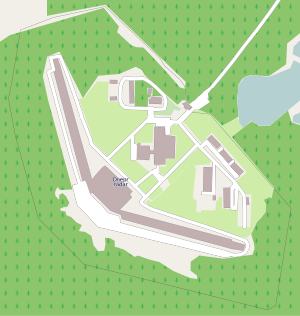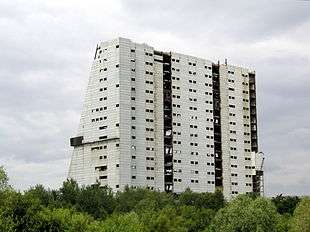Mukachevo Radar Station
Mukachevo radar station was a Soviet radar station providing early warning of ballistic missile attack. Currently it is the property of the State Space Agency of Ukraine.[3] It is located in Shipka in the far south west of Ukraine and was part of the Soviet, and then Russian missile attack warning system. Information from this station could be used for a launch on warning nuclear missile attack[4] or to engage the A-135 anti-ballistic missile system.
| Mukachevo radar station | |
|---|---|
| Shipka, Mukacheve, Ukraine | |
 Map of Mukachevo Dnepr | |
 Mukachevo radar station | |
| Coordinates | 48.37768°N 22.70744°E |
| Type | Radar station |
| Code | RO-5 [1] |
| Height | 75 metres (246 ft)[2] |
| Site history | |
| Built | 1970s |
| Built by | Soviet Union |
Radar

The radar is a Dnepr (NATO name: HEN HOUSE) phased array radar, and was the last one of this type to be built by the Soviet Union.[5] It consists of a central building and two long wings over 250 metres long; each wing is a separate radar array. One had an azimuth of 196° (south west) and the other 260° (facing west).[5] The radar had a range of 3,000 kilometres (1,864 mi).[6]
The radar started to be built in the early 1970s. Some sources say that it started operating in 1977,[7] others say it became operational on 16 January 1979.[5][8]
A second generation radar, a Daryal-UM, was started at a different location outside of Mukacheve, 6.7 kilometres (4.2 mi) away, north of the village of Pistryalovo. It was planned that this would replace the Dnepr but construction stopped in 1991, when the Soviet Union collapsed, and never restarted.[5] The Daryal has separate receiver and transmitter buildings, at Mukachevo they are 630 metres (2,070 ft) apart. The transmitter building is ruined, was being demolished in autumn 2011, and is at 48°23′6.56″N 22°48′1.72″E.[9] The larger receiver building has been demolished and was located at 48°23′18.41″N 22°47′37.71″E. The azimuth of the Daryal was 218° (south west).[5]
Dispute with Ukraine
In 1991 the Soviet Union collapsed and the station ended up in the newly independent country of Ukraine, together with the radar in Sevastopol. Russia signed a 15-year agreement with Ukraine in 1992 to rent both radars for $840,000 per year, although unlike other overseas stations the radar was to be staffed by Ukrainians not Russians.[10][11] In 2005 management of the radars transferred from the military to the civil Ukrainian National Space Agency and the rent increased to $1.3 million, although Ukraine asked for more.[8][12]
In 2008 Russia decided to stop using information from the two Ukrainian radar stations.[13][14] According to some commentators it was partly about the then Ukrainian government's stated intention to join NATO.[10][13] In 2007 Vladimir Popovkin had stated that Russia intended to duplicate or replace foreign radar stations as it could not rely on them in times of crisis.[15] Replacing the station would reduce any leverage Ukraine was gaining over Russia from the ability to control access to the data.[10][11][16]
Pragmatic reasons were given for ending the lease. Popovkin said that the radars went out of warranty in 2005, and would cost $20m to modernise. In addition Russia said that the data from Sevastopol was unreliable due to pirate radio broadcasts from fishing boats in the Black Sea.[13][14] Furthermore, it had concerns with the quality of the data due to the civilian rather than military operators.[13][17]
Data from Ukraine stopped on 26 February 2009 and Russia declared that a new Voronezh radar station in Armavir had begun operation on the same date, replacing the lost coverage.[18][19]:76 Following this the Ukrainian government announced that the stations would be closed for a month for maintenance and then used part-time for space surveillance, being part of an organisation called SKAKO (Automatic System of Control and Analysis of Outer Space).[20][21]
External links
References
- Всевидящий глаз России [Seeing Eye Russia]. Novosti Kosmonavtiki (in Russian) (5): 52–53. May 2009.(subscription required)
- Bukharin, Oleg; Kadyshev, Timur; Miasnikov, Eugene; Podvig, Pavel; Sutyagin, Igor; Tarashenko, Maxim; Zhelezov, Boris (2001). Podvig, Pavel (ed.). Russian Strategic Nuclear Forces. Cambridge, Massachusetts: MIT Press. ISBN 978-0-262-16202-9.
- "Закарпатське Мукачево: На вістрі “холодної війни”, або Таємниці "Шипки""
- Podvig, Pavel (1994). "The Operational Status of the Russian Space-Based Early Warning System" (PDF). Science and Global Security. 4 (3): 363–384. doi:10.1080/08929889408426407. ISSN 0892-9882.
- Podvig, Pavel (2002). "History and the Current Status of the Russian Early-Warning System" (PDF). Science and Global Security. 10: 21–60. CiteSeerX 10.1.1.692.6127. doi:10.1080/08929880212328. ISSN 0892-9882. Archived from the original (PDF) on 2012-03-15.
- Мощные РЛС дальнего обнаружения РЛС СПРН и СККП [Powerful radar early warning radar early warning system and space surveillance] (in Russian). RTI Mints. n.d. Archived from the original on 2012-12-02. Retrieved 2012-01-30.
- Marinin, I (2011). Отечественной СПРН – 40 лет [Patriotic SPRN - 40 years] (in Russian). Novosti Kosmonavtiki. Archived from the original on May 20, 2012. Retrieved 20 June 2012.
- "Russia Won't Rent Ukrainian Radar". Kommersant. 2008-01-16. Retrieved 2012-01-30.
- В Закарпатье при демонтаже Пестряловской РЛС погиб человек [In Transcarpathia a man was killed demolishing a radar] (in Russian). UA-REPORTER. 2011-10-03. Retrieved 2012-07-19.
- Wilk, Andrzej (2008-01-29). "Russia starts to dismantle the Soviet early warning system". Centre for Eastern Studies. Archived from the original on 2012-12-02. Retrieved 2012-07-09.
- Kramnik, Ilya (2009-02-26). Арифметика СПРН: минус два "Днепра", плюс один "Воронеж" [Early warning arithmetic: minus two Dnepr, plus one Voronezh] (in Russian). RIA Novosti. Retrieved 2012-07-15.
- "Ukraine Sends a Warning to Russia". Kommersant. 2005-02-11. Archived from the original on 2005-02-23. Retrieved 2012-07-11.
- "Russia to stop using Ukrainian radars". RIA Novosti. 2008-02-04. Retrieved 2012-01-30.
- Podvig, Pavel (2008-02-25). "Russia pulls out of an early-warning arrangement with Ukraine". Russian strategic nuclear forces. Retrieved 2012-02-01.
-
Marinin, I; Kuznetsov, A (February 2007). "THE FIRST VORONEZH ON EXPERIMENTAL COMBAT DUTY". Novosti Kosmonavtiki (2): 64–65. Retrieved May 2012. Check date values in:
|accessdate=(help)(subscription required) - "Russia will deploy the new early-warning radar deal with U.S. anti-missile system in Eastern Europe". 9ABC [Chinese Military]. 2011-02-09. Archived from the original on 2013-02-21. Retrieved 2012-07-10.
- Podvig, Pavel (2007-07-13). "Russia will no longer use early-warning radars in Ukraine". Russian strategic nuclear forces. Retrieved 2012-02-01.
- Podvig, Pavel (2009-02-12). "Armavir radar fills the gap". Russian strategic nuclear forces. Retrieved 2012-01-09.
- Baev, Pavel (2010). "Neither Reform nor Modernisation: the Armed Forces Under and After Putin's Command". In Galeotti, Mark (ed.). The Politics of Modern Security in Russia. Ashgate. pp. 69–88. ISBN 978-0-7546-7408-5.
- "Ukrainian radars withdrawn from operation in Russia's interests to undergo technical maintenance". Kyiv Post. 2009-02-26. Retrieved 2012-07-11.
- "Source: Ukraine radar to be used to protect German satellites". Kyiv Post. 2010-02-09. Retrieved 2012-07-11.